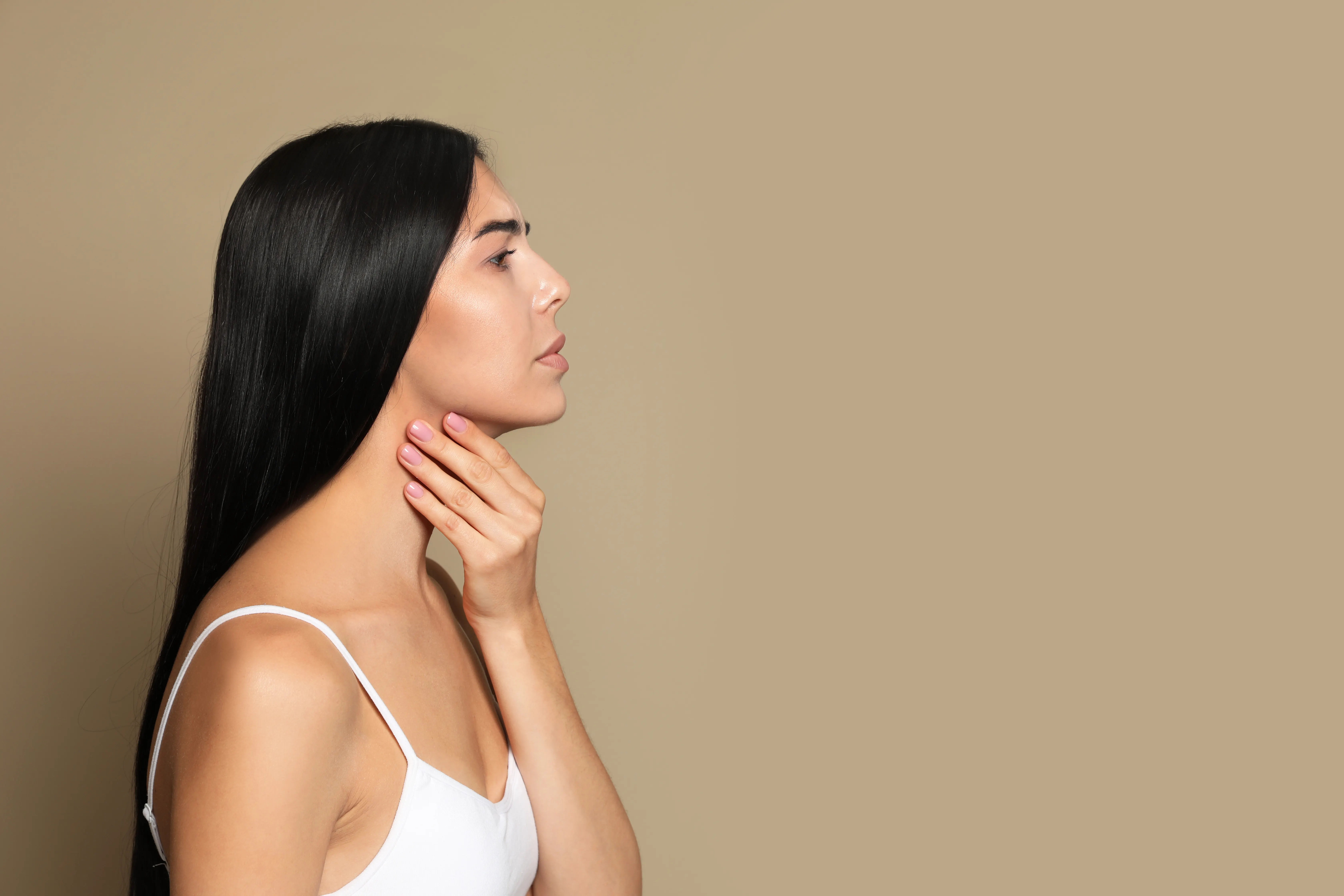Key Insights into the Thyroid Gland Location
Explore the thyroid gland's location, its anatomical relations with surrounding structures, and variations like ectopic thyroid tissue. Learn the significance of thyroid positioning in diagnostics, surgery, and managing disorders like goitre and nodules.

Written by
Last updated on 3rd Jul, 2025
The thyroid gland is one of the main endocrine organs in the body. It is responsible for the production of hormones like thyroxine (T4) and triiodothyronine (T3), which control metabolism, growth, and development. The gland also plays a role in calcium homeostasis by releasing calcitonin, but its role is much less significant than that of the parathyroid glands.
This article demonstrates the location of the thyroid gland, its surrounding structures, their variations and significance in the human body.
Understanding the Thyroid Gland Location
The thyroid gland is located adjacent to critical structures such as the trachea and the oesophagus. Understanding its anatomy is essential to evaluating and treating thyroid disorders. It helps professionals safely perform other procedures, including imaging, biopsies, and surgeries, decreasing adverse events.
Anatomical Position of the Thyroid Gland
The anatomical position of the thyroid covers what lies above, below, behind, in front, and lateral to it.
Location Relative to Other Neck Structures
The thyroid gland is located in the anterior area of the neck, under the larynx and in front of the trachea. Its lobes usually extend from the level of the thyroid cartilage to the sixth tracheal ring.
Because it is located superficially, it can be assessed by palpation in routine clinical examinations. The fibrous sheath around the gland not only protects it but also allows for easy movement when swallowing.
Description of the Thyroid Lobes and Isthmus
- The gland has two lateral lobes connected by a narrow bridge (the isthmus).
- Each lobe is conical, with its apex toward the thyroid cartilage and base facing the clavicle.
- In specific individuals, the pyramidal lobe extends from the isthmus, a remnant of embryological development.
Embryological Development of the Thyroid Gland
The anatomical position of the thyroid gland and the potential movement can be studied with the development of the organ.
Origins and Developmental Process
The thyroid gland develops from the floor of the embryonic pharynx during the fourth week of embryonic development.
It starts as an epithelial proliferation known as the thyroid primordium, located at the foramen cecum (a depression at the base of the tongue).
Migration and Final Positioning in the Neck
During development, the thyroid primordium migrates inferiorly via the thyroglossal duct to reach its final resting place in the anterior neck by the seventh week.
Usually, the thyroglossal duct regresses, but incomplete regression or improper migration may cause variations, such as ectopic thyroid tissue.
Surrounding Structures and Their Relations
Relationships of superlateral structures with the thyroid gland are essential for clinical assessment of the gland.
Thyroid Gland’s Relationship with Trachea and Esophagus
The thyroid gland partially surrounds the trachea and is next to the oesophagus. Enlargement of the gland, such as in goitre, may compress these structures, leading to symptoms such as dysphagia or dyspnea.
Vascular Structures Around the Thyroid Gland
The blood supply for the gland comes from:
- The superior thyroid artery (branch of the external carotid artery)
- The inferior thyroid artery (a branch from the thyrocervical trunk)
Venous drainage is done through the superior, middle, and inferior thyroid veins. Awareness of various vascular relationships is of paramount importance during any surgical procedure to avoid fatal complications like haemorrhage.
Variations in Thyroid Gland Location
A study of physiological variants and ectopic locations of the thyroid gland can help with diagnosis and management.
Normal Anatomical Variations
Anatomical variations in the thyroid gland include:
- The absence of an isthmus
- The presence of additional lobes
About half the individuals possess a pyramidal lobe, a normal developmental variant.
Ectopic Thyroid Tissue Locations
Ectopic thyroid tissue can be found anywhere along the descent of the thyroglossal duct, including the tongue base (lingual thyroid).
In a few cases, ectopic tissue is present in the mediastinum or distant sites and may require advanced diagnostic imaging to identify accurately.
Clinical Significance of Thyroid Gland Location
The anatomical position of the thyroid gland is clinically notable. It significantly influences both diagnosis and treatment approaches.
Implications for Thyroid Surgery
The thyroid gland's close anatomical proximity to critical structures, such as the recurrent laryngeal nerve and parathyroid glands, poses a risk of damage during thyroidectomy.
Patients may also experience long-term effects, including:
- Complications related to nerve injury or
- Inadvertent removal of parathyroid glands.
Obstacles in Thyroid Gland Examinations and Biopsies
Deviations from the gland’s size or ectopic placement can further complicate clinical assessments. An accurate evaluation of its location and structure may demand complementary imaging techniques, like ultrasound or computed tomography (CT).
Diagnostic Techniques for Studying Thyroid Gland Location
Diagnostic strategies give useful insights into the position, structure, and abnormalities of the thyroid gland.
Physical Examination Methods
Palpation is a key method to assess the thyroid gland. Clinicians can assess the gland’s size, consistency, and mobility by inspecting the neck during swallowing.
Imaging Modalities (Ultrasound, CT, MRI)
The imaging modality of choice for detailed evaluation of the thyroid gland is ultrasound. It offers high-resolution images of the gland’s structure, blood supply, and any nodules it contains.
When complex cases arise, such as retrosternal or ectopic thyroid tissue, complex imaging techniques like computed tomography (CT) and magnetic resonance imaging (MRI) are used.
Common Disorders Related to Thyroid Gland Location
The thyroid gland’s location disorders can develop with considerable clinical implications.
Goitre and Its Impact on Surrounding Structures
An enlarged thyroid gland, called goitre, can compress adjacent structures like the trachea and oesophagus. This situation can cause difficulty breathing and swallowing, especially with retrosternal goitres that grow into the chest cavity.
The Significance of Thyroid Nodules’ Location
The location of thyroid nodules can help determine their potential impact on nearby structures, such as the airway or nerves, and their likelihood of being malignant. Nodules that are posterior or in ectopic tissue may need advanced imaging for diagnosis and treatment planning.
Practical Tips for Healthcare Providers
Healthcare providers can improve patient care by adhering to certain principles in thyroid evaluation and management.
How to Accurately Assess Thyroid Gland Size and Position
Physical examination and imaging techniques complement each other in providing a total assessment of the thyroid gland. Accurate diagnosis requires an understanding of variations, such as ectopic tissue.
Considerations During Thyroid-Related Procedures
An accurate comprehension of the anatomy of the thyroid gland and surrounding structures is required for planning surgical and diagnostic procedures involving the gland. Proper imaging in advance and careful surgical planning are key.
Conclusion
The location of the thyroid gland within the anterior neck and its relations with surrounding structures underscores the need for high-quality anatomical knowledge. Understanding normal variations and developmental abnormalities improves diagnostic accuracy and treatment results. It helps clinicians individualise patient care and minimise the risk of adversity.
Consult Top Endocrinologist
Consult Top Endocrinologist

Dr G Prathyusha
General Physician/ Internal Medicine Specialist
5 Years • MBBS DNB (Family medicine), CCEBDM (Diabetology), PGDGM (Geriatrics), Primary care Rheumatologist.
Bengaluru
PRESTIGE SHANTHINIKETAN - SOCIETY CLINIC, Bengaluru

Dr. Sushith C
General Physician
2 Years • MBBS
Bengaluru
PRESTIGE SHANTHINIKETAN - SOCIETY CLINIC, Bengaluru

Dr Venkata Naga Sai Tribhushan Rambhatla
General Physician
3 Years • MBBS
Bengaluru
PRESTIGE SHANTHINIKETAN - SOCIETY CLINIC, Bengaluru

Dr. Chaithanya R
Internal Medicine Specialist Diabetologist
16 Years • MBBS, MD Internal Medicine, Fellowship in Diabetes(UK), CCEBDM(PHFI)
Bangalore
Apollo Clinic Bellandur, Bangalore
Dr Sumanth R
General Physician
2 Years • MBBS
Bengaluru
PRESTIGE SHANTHINIKETAN - SOCIETY CLINIC, Bengaluru

